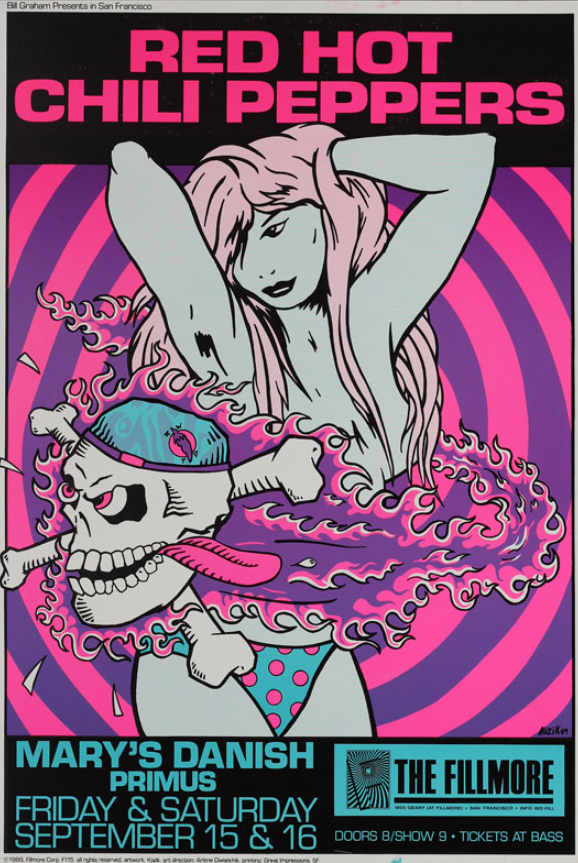Jolly Roger

Frank Kozik Red Hot Chili Peppers Primus 1989 Fillmore Silkscreen San Francisco CA Print by Frank Kozik
Red Hot Chili Peppers Primus 1989 Fillmore Silkscreen San Francisco CA Print by Frank Kozik Hand-Pulled on Fine Art Paper Limited Edition Pop Street Art Artwork. 1989 Kozik Artwork Size 13x19 Silkscreen Print Band Gig Poster by Frank Kozik. Bill Graham San Francisco The Fillmore Poster F115 Red Hot Chili Peppers Mary's Danish Primus September 15 16, 1989 In concert poster art, few names are as synonymous with the medium as Frank Kozik. His creation for the Red Hot Chili Peppers, Primus, and Mary's Danish gig at The Fillmore in San Francisco on September 15 and 16, 1989, is a vivid example of his dynamic contribution to the genre. The print, marked as F115 in the catalog of Bill Graham's legendary venue posters, represents an era when rock music and visual art found a harmonious and often rebellious coexistence. This hand-pulled silkscreen print, with dimensions of 13x19 inches, is more than a mere announcement of an event; it's a piece of art that captures the raw vigor of the late 1980s music scene in San Francisco. Featuring a striking illustration that embodies the psychedelic and funky vibes of the Red Hot Chili Peppers and the eccentricity of Primus, Kozik's work is a nod to the era's graphic sensibilities, mixing pop art influences with street art's accessibility and edge. Limited editions of such prints are sought after not just for their scarcity but also for their representation of a specific cultural moment. Kozik's prints are known for their bold lines, eye-catching color palettes, and unique interpretation of band personas, and this piece is no exception. The blending of vibrant pinks and purples with the striking image of a cartoonish skeleton figure reflects the energy and boundary-pushing styles of the featured bands. This particular print is a testament to the enduring legacy of a time when The Fillmore was as much a hub for visual innovation as it was for musical performances. Kozik's artwork for this show stands as an iconic piece of pop and street art, bridging fans with the memorable experience of live music and the tactile quality of fine art paper. It encapsulates a period when posters were not only promotional tools but also collectible works of art that fans and art lovers would cherish for decades.
$468.00

